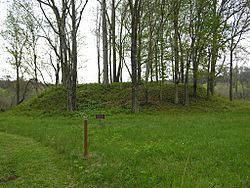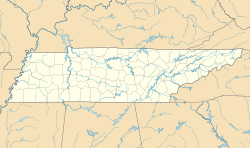Sellars Farm site facts for kids

The main mound at the site
|
|
| Alternative name | Sellars Farm state archaeological area, Sellars Indian mound |
|---|---|
| Location | Lebanon, Tennessee, Wilson County, Tennessee, |
| Region | Middle Tennessee |
| Coordinates | 36°10′12.1″N 86°14′26.37″W / 36.170028°N 86.2406583°W |
| History | |
| Founded | 1000 CE |
| Abandoned | 1300 CE |
| Cultures | Mississippian culture |
| Site notes | |
| Architecture | |
| Architectural styles | platform mound |
| Architectural details | Number of temples: 1 |
|
Sellars Indian Mound
|
|
| NRHP reference No. | 72001256 |
| Responsible body: State of Tennessee | |
The Sellars Farm site (also known as the Sellars Indian Mound) is an ancient place in Wilson County, Tennessee, near Lebanon, Tennessee. It is an archaeological site from the Mississippian culture. People lived here and built a large platform mound between about 1000 and 1300 CE.
Today, the Sellars Farm site is part of Long Hunter State Park. A group called the Friends of the Sellars Farm State Archaeological Area helps take care of the site. They also give tours to visitors. This important historical spot was added to the National Register of Historic Places on December 11, 1972.
Contents
Who Were the Mississippian People?
The Mississippian culture was a group of Native American people. They lived in what is now the southeastern United States. They existed from about 800 CE to 1600 CE. These people were known for building large mounds of earth.
They were also skilled farmers. They grew crops like corn, beans, and squash. Mississippian towns were often well-organized. They had central plazas and important buildings on top of mounds.
What is a Platform Mound?
A platform mound is a special type of earth mound. It has a flat top, like a platform. The Mississippian people built these mounds for important reasons. They were not usually burial mounds.
Instead, they often built temples or homes for their leaders on top of these flat platforms. The main mound at Sellars Farm is a platform mound. It shows that this was an important settlement.
Life at Sellars Farm
The Sellars Farm site was a busy settlement for about 300 years. People lived, worked, and worshipped here. The large platform mound suggests that it was a significant community. It might have been a center for trade or ceremonies.
Archaeologists study sites like Sellars Farm. They learn about how ancient people lived. They look at tools, pottery, and other items. These items tell us about their daily lives.
Important Discoveries at Sellars Farm
Many interesting things have been found at Sellars Farm. One of the most famous discoveries is a collection of sandstone figurines. These are statues carved from stone. They show human figures.
One of these statues is very well-known. It is called "Sandy." This statue was even featured on a United States postage stamp. "Sandy" is also the official State Artifact of Tennessee. This shows how important the discoveries at Sellars Farm are.
Protecting the Site
The Sellars Farm site is a protected area. It is important to preserve these ancient places. They help us understand the history of Native American cultures. The State of Tennessee is responsible for its care.
The Friends of the Sellars Farm organization helps keep the site in good condition. They also teach people about its history. Visiting the site can help you imagine what life was like long ago.


